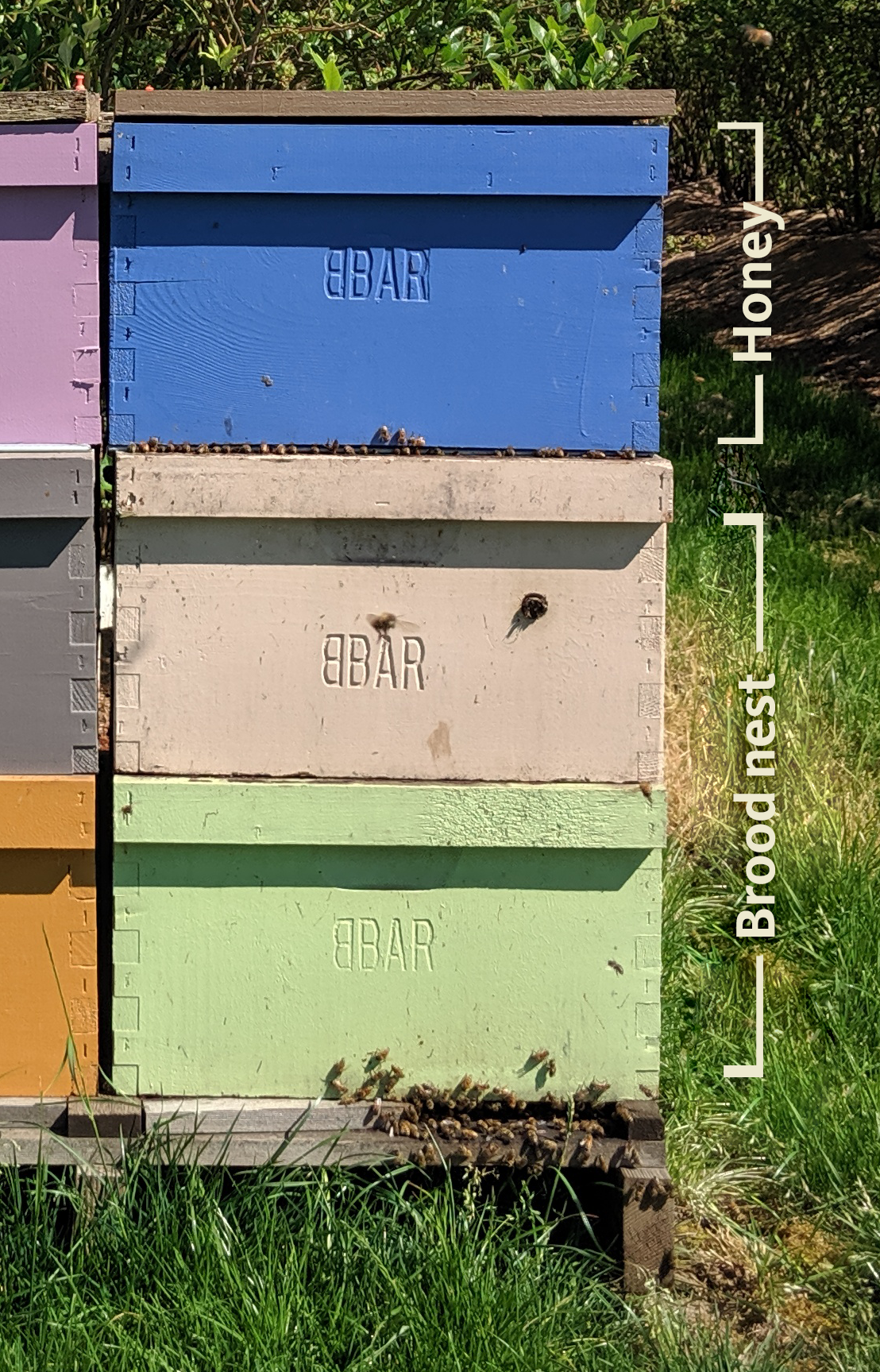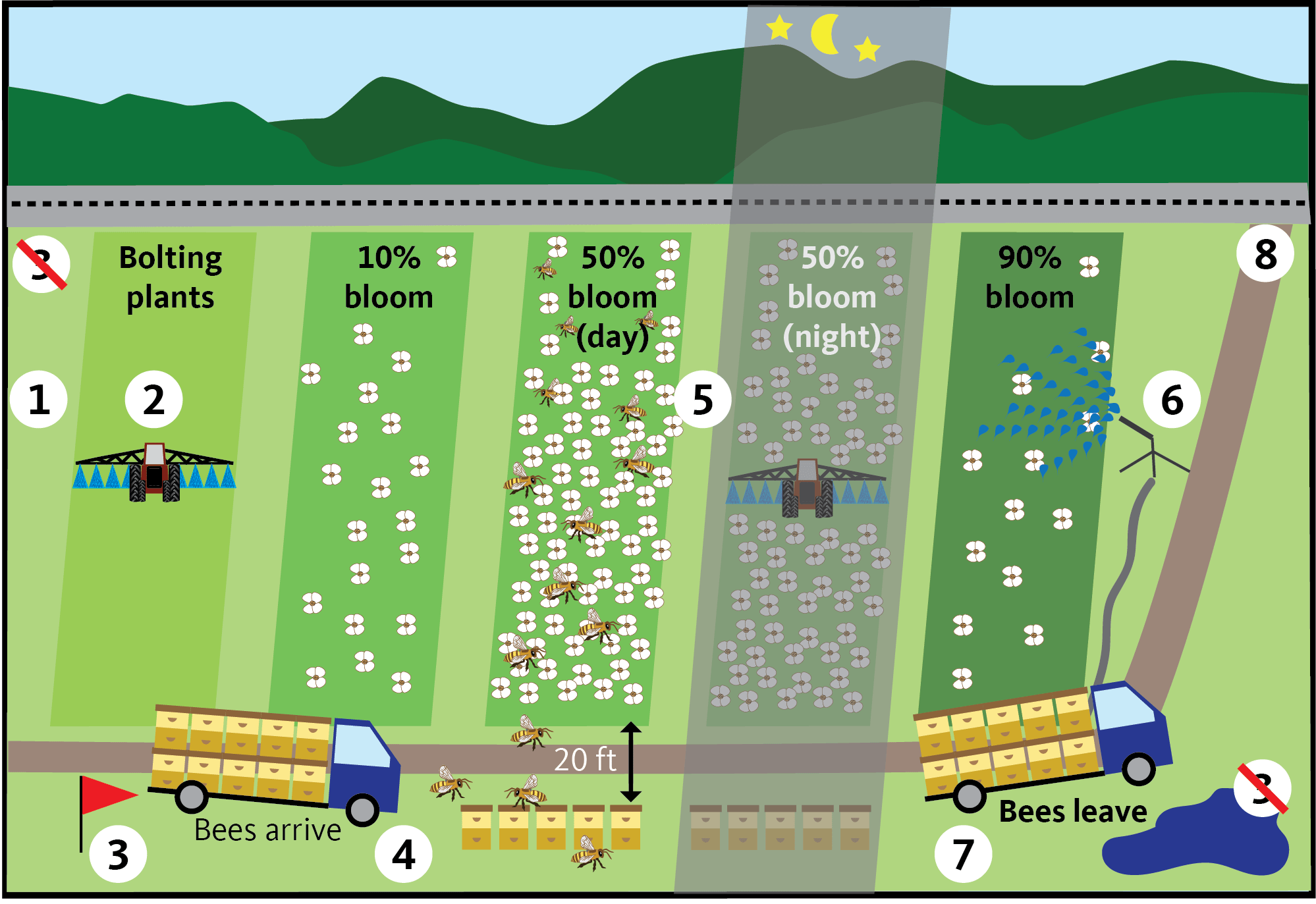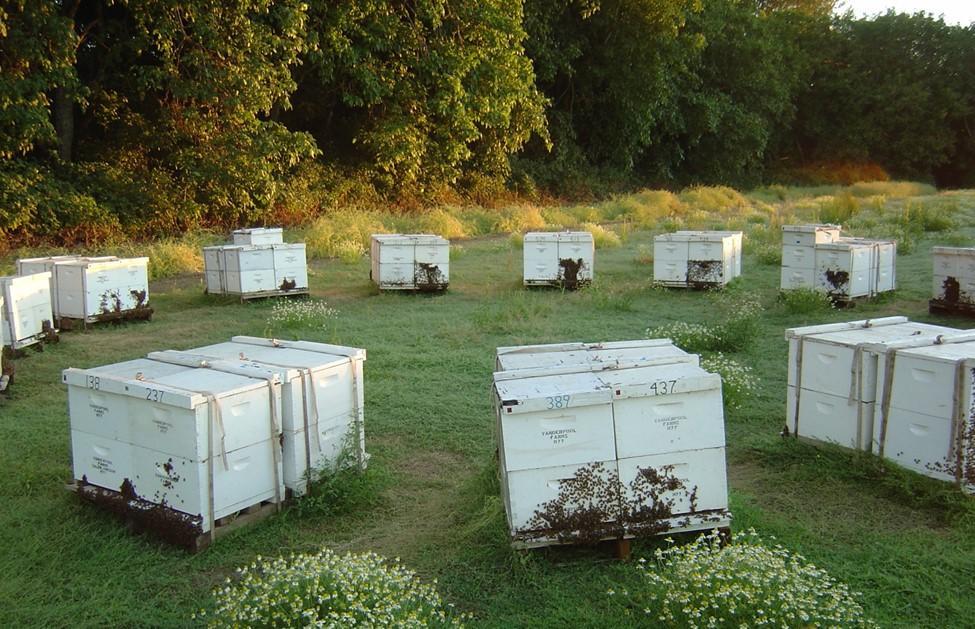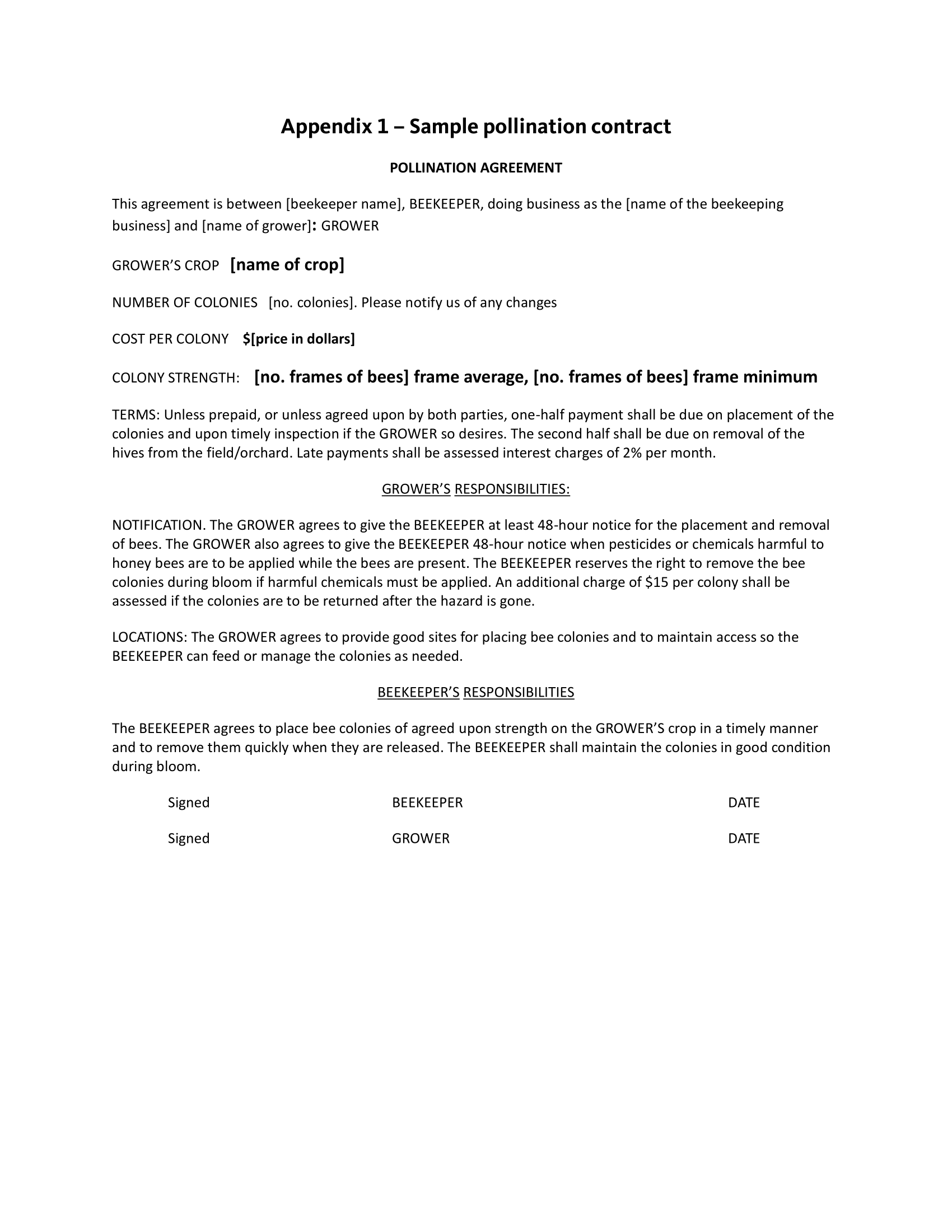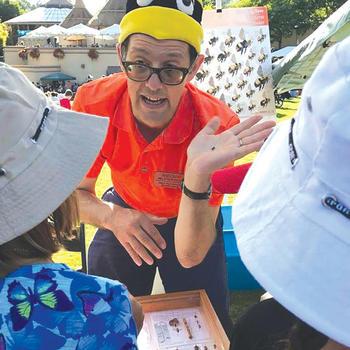Seeds grown in western Oregon are critical to the production of many vegetable and cover crops grown across the globe. More than 14,000 acres are planted to specialty seeds in western Oregon, a 2012 report estimated, with a farm gate value of around $50 million.
Bee pollination is key to this production. Survey results from 2016 indicate that over 20,000 colonies, from over a third of commercial beekeepers in the Pacific Northwest, pollinate specialty seed crops. This figure also includes colonies used for carrot seed pollination, which is largely located in in eastern Oregon. The major specialty seed crops grown in western Oregon that honey bees pollinate are coriander, meadowfoam, onion and crucifer crops (radish, turnip, rutabaga, daikon, mustard).
There has traditionally been a mutually beneficial working relationship between members of the Specialty Seed Growers of Western Oregon and Oregon beekeepers. In 2017, the SSGWO met with a working group from the Oregon State Beekeepers Association to establish the state’s first Bee Protection Protocol.
Together they established standard practices to ensure sustained partnership among specialty seed growers and beekeepers around five key areas:
- Honey bee pollination (the strength, placement and timing of movement of honey bee colonies).
- Pest management around crop bloom.
- Maintaining clear communications among all growers, applicators, crop consultants and beekeepers leading up to the placement of colonies until their removal.
- Conveying the key elements of the protocol to all involved parties.
- Promoting the protocol to nonfarm groups concerned about pollinators.
Elements of the protocol
Honey bee pollination
Colony strength and stocking rate
Strong honey bee colonies are required to ensure adequate pollination of specialty seed crops. A honey bee colony used for specialty seed crops will typically be housed in three or four boxes, with the bottom two boxes being where the queen lays eggs (brood nest) and additional boxes being where honey is stored (super) (Figure 1). Colony strength is comprised of three parts:
- The size of the workforce of foraging workers.
- The size of the brood nest, which is comprised of the number of immature bees and their attending adult nurses.
- The presence of a single laying queen.
Only a colony with a healthy and growing brood nest will provide a large pollinating workforce.
Oregon regulations (as outlined in Evaluating Honey Bee Colonies for Pollination, PNW 623) specify that colonies being used for field crops, such as specialty seeds, should have six standard (Hoffman) frames well-filled with brood and 10 standard frames well-filled with adult bees (Grade A — Figure 1). A Grade B colony fails to meet the requirement for brood and adult bees by no more than 25% and may result in a lower rental fee. Colonies below a Grade B strength should not be provided for pollination.
Growers can monitor colony strength by watching flight at the entrance of the colony. Preliminary data suggest that a pollination-grade colony should have around 90 incoming bees per minute at 65ºF and above, when winds are less than 10 miles per hour. Maximal foraging will not take place until ambient temperatures rise above 60°F. The grower should report colonies that are weak or inactive to the beekeeper.
The number of colonies per acre (the stocking rate) can also influence the number of bees pollinating the crop. The stocking rate for Western specialty seeds generally ranges between two or three colonies per acre and may be adjusted according to the attractiveness of the crop and variety, whether pollinating a hybrid or open-pollinated variety, and the amount of surrounding competing bloom.
Communicate with your beekeeper at least 10 days before you need your bees, but preferably call your beekeeper in February or March to firm up your plans for the season and to determine the number of bees you will need for the coming year (Figure 3.1).
Timing of colony arrival and departure
Colonies should be moved into fields around 10% bloom to ensure adequate crop bloom to hold the bees so they do not seek bloom elsewhere (Figure 3.4). Delaying bee placement until bloom is at 10% also maximizes time for safe insecticide sprays before bees arrive (see Section B, Figure 3.2). The grower and beekeeper should communicate around 50% bloom (approximately when the field has peak blossom color) to determine when the colonies should be removed.
In some hybrid seed production systems beekeepers use a staged-colony removal approach and remove half of the colonies at 50% bloom and the remaining colonies at 90% bloom. In other situations, the beekeepers may want to remain in the location after pollination is complete, as long as it does not interfere with the management of the crop. Growers may want to draw colonies down earlier if insect pressure is high and there is a need to apply an insecticide.
Placement of colonies
Ideally the location for colonies during pollination will be (Figure 3.3):
- Accessible by the beekeeper and free of obstruction at all times during bloom, as the beekeeper will need to periodically manage colonies.
- Outside of the range of irrigation spray guns and pooling irrigation water (Figure 4).
- At least 20 feet from the edge of the crop to prevent directly spraying the colonies with pesticides (Figure 4).
- Not directly adjacent to highways as this can result in collisions with bees and the dwindling of the pollinating workforce over time.
Growers should provide clear instructions for bee drop-off in advance of the beekeepers’ arrival. Ideally, the grower and beekeeper should meet before bloom to discuss colony placement, as beekeepers will be placing colonies at night and may not be able to locate drop locations. Flagging locations, as well as nearby wheel line irrigation tracks, will help ensure correct placement and help avoid collisions between honey bee colonies and irrigation equipment (Figure 5).
Care of bees during pollination
Colony strength can change during pollination. A good beekeeper will service the colonies during pollination to ensure the colonies remain productive. This includes ensuring colonies remain queenright (meaning they have a healthy, mated queen) and that brood nests do not become full of nectar, which can lead to swarming.
A good beekeeper can ensure colonies retain a strong foraging force and maximize seed set. Growers need to factor in beekeeper access to colonies during pollination to ensure colonies remain at full strength (Figure 3.8).
Growers should ensure field workers, seed companies and outside contractors have clear instructions to provide a wide berth to pallets of beehives and understand the serious nature of knocking over or disturbing the colonies (Figure 5).
Pest management and honey bees
Pest management and exposure risk
The risk of pesticide application to honey bees is the product of four factors (Figure 2):
- The toxicity of the product to honey bees.
- Whether the application is made on blooms attractive to bees or not.
- The residual time of the product.
- The formulation of the product.
The risk of a pesticide application to honey bees is significantly reduced by applying treatments immediately before bloom (at the bolting phase for crucifer crops, for example) or after colonies are removed from fields (Figure 3.5). Avoid pesticide applications during bloom, unless pest or disease pressures are high. If sprays are made around bloom, growers should consult with their beekeeper if they need to apply a pesticide treatment during the pollination period to arrive at a mutually agreeable plan of action.
Pests and diseases around bloom
In general, only crucifer seed crops will require treatment in and around bloom time. Coriander and onion generally only require treatments outside the bloom period. Insect pests that can cause damage around bloom in crucifer crops include lygus bug (Lygus spp.), cabbage seedpod weevil (Ceutorhynchus obstrictus), cabbage and turnip aphids (Brevicoryne brassicae and Hydaphis pseudobrassicae, respectively) and cabbage maggot (Delia radicum, if transplant/seeding treatments are ineffective).
Most insect pests of crucifer seed crops can be managed with a broad-spectrum insecticide at the bolting stage and with a cleanup spray after bees depart. Only rarely will growers treat during bloom if they are diligent with their sprays at the bolting stage.
Crucifer seed growers may need to control a number of fungal diseases during bloom, including sclerotinia soft rot (Sclerotinia sclerotiorum), alternaria leaf and pod spot (Alternaria brassicae and A. brassicicola), and downy mildew (Peronospora parasitica). These diseases can result in repeated applications of fungicides at seven- to 14-day intervals, frequently in tank mixtures of products with different Fungicide Resistance Action Committee codes in order to prevent the development of fungicide resistance.
Insecticides around bloom
Bolting-stage sprays: Treatment with a broad-spectrum insecticide at the bolt-stage before honey bees arrive should largely eliminate the need for applying an insecticide during bloom in crucifer seed crops. All the insecticides labeled for crucifer seed crops are toxic to bees (Table 1). Although pesticide labels do not indicate how long pesticides remain toxic to bees after spray, research from OSU indicates bee toxicity of the most widely used broad-spectrum insecticide (products containing bifenthrin) is largely weathered down within four days after treatment. Consequently, bees should be moved in at least four days after treatments are applied.
Cleanup sprays: Typically, cabbage seedpod weevil populations will increase during the bloom period. Monitor weevil populations. If levels are high, wait until colonies have been removed from the field before treating. If levels are increasing quickly and bloom is starting to wane, consider releasing the colonies early to apply treatments.
Bloom sprays: Effective bolting stage sprays at bloom eliminate the need for insecticide treatments at bloom. If insect monitoring indicates high pest pressure during peak bloom, growers must use products with short residual times and apply treatments when bee activity is reduced (after 8 p.m. and before midnight). Unfortunately, most insecticides labeled for crucifer seed crops remain toxic for longer than eight hours, and, as such, will remain toxic the next morning if sprayed at dusk. There are two exceptions (Table 1). Methomyl (Lannate) is the only labeled product with a residual time shorter than eight hours under the Environmental Hazards section (Table 1). Cyantraniliprole (Exeril) also has short residual time on leaf material (less than three hours). The product label, however, indicates treatments during bloom should be avoided, and bloom time treatments are restricted to situations where beekeepers are provided with 48-hour notice to cover or remove their colonies.
Finally, when bees are in fields, runoff from the washing and rinsing of pesticide application equipment must be contained and not allowed to pool where bees gather water (a 2-mile radius of the colonies). These containment procedures are particularly important in mid- to late-summer heat when bee foraging for water is at its peak.
| Active ingredient | Products | Toxicity to honey bees (label language)1 | Residual toxicity (label language)2 | RT253 |
|---|---|---|---|---|
| Bolting-stage/ post-bloom cleanup | ||||
| Bifenthrin | Brigade 2EC | Highly toxic | Do not apply this product or allow it to drift to blooming crops or if bees are visiting the treatment area. | EPA: n/a. OSU (radish): ~96h Environmental hazards: >8h |
| Cyantraniliprole | Exirel | Highly toxic | Do not apply this product while bees are foraging. Do not apply this product until flowering is complete and all petals have fallen unless the following conditions have been met. - If an application must be made when managed bees are at the treatment site, the beekeeper providing the pollination services must be notified no less than 48 hours prior to the time of the planned application so that the bees can be removed, covered or otherwise protected prior to spraying. | EPA: 3h OSU (radish): <3h Environmental hazards: >8h |
| Carbaryl | Sevin | Extremely toxic | Do not apply this product or allow it to drift to blooming crops or weeds if bees are visiting the treatment area. | EPA: 42h Environmental hazards: >8h |
| Lambda- cyhalothrin | Silencer, Warrior II | Toxic | Do not apply this product or allow it to drift to blooming crops or weeds if bees are visiting the treatment area. | EPA: 22h (0.013lb ai/ai) 54h (0.031 lb ai/A) Environmental hazards: >8h |
| Zeta -cypermethrin | Mustang Maxx | Highly toxic | Do not apply this product or allow it to drift to blooming crops if bees are visiting the treatment area. | EPA: n/a Environmental hazards: >8h |
| Esfenvalerate | Asana XL | Highly toxic | Do not apply this product or allow it to drift to blooming crops if bees are visiting the treatment area. Asana XL can act as a bee repellent, do not apply within seven days of pollination. | EPA: n/a Environmental hazards: >8h |
| Methomyl | Lannate | Highly toxic | Do not apply this product or allow it to drift to blooming crops or weeds while bees are actively visiting the treatment area. | EPA: n/a Environmental hazards: <8h |
| Bloom | ||||
| Iprodione | Rovral | No warning | - | - |
| Chlorothalonil | Bravo | No warning | - | - |
| Cyantraniliprole | Exirel | Highly toxic | Do not apply this product while bees are foraging. Do not apply this product until flowering is complete and all petals have fallen unless the following conditions have been met. - If an application must be made when managed bees are at the treatment site, the beekeeper providing the pollination services must be notified no less than 48 hours prior to the time of the planned application so that the bees can be removed, covered or otherwise protected prior to spraying. | EPA: 3h Environmental hazards: >8h |
| Methomyl | Lannate | Highly toxic | Do not apply this product or allow it to drift to blooming crops or weeds while bees are actively visiting the treatment area. | EPA: n/a Environmental hazards: <8h |
-
Toxicity language is outlined in EPA’s Label Review Manual. Insecticides that kill more than 50% of test honey bees in laboratory trials (LD50) at a dose lower than 2 mg/bee are labeled “highly toxic to bees” under the environmental hazards section of the pesticide label. Insecticides with an LD50 less than 11 mg/bee but greater than 2 mg/bee are labeled “toxic to bees.” Products with LD50 values above 11 mg/bee will have no bee toxicity warning on the label.
-
Bee residual toxicity language is outlined in EPA’s Label Review Manual. Insecticides that dissipate within eight hours to levels that kill fewer than 25% of the bees (RT25) will have the following phrase on the label under environmental hazards: “Do not apply this product or allow it to drift to blooming crops or weeds while bees are actively visiting the treatment area.” Insecticides that remain toxic to bees after eight hours of weathering (RT25 > 8 hours) have the phrase: “Do not apply this product or allow it to drift to blooming crops or weeds while bees are visiting the treatment area.”
-
RT25 is the residual time needed to reduce the activity of the test substance and bring bee mortality down to 25% in cage test exposures to field-weathered spray deposits. EPA has published RT25 values. Where EPA has not published RT25 values, they have been inferred from the residual toxicity statement on the label (see point 2, above). Finally, recent research from OSU is also listed.
Fungicides around bloom
Unlike insecticides, there are no label restrictions associated with the use of fungicides. When disease pressure is high, fungicides may need to be applied on a seven- to 14-day schedule throughout the bloom period. Moreover, growers are advised to rotate products from different FRAC groups to avoid the development of resistance.
The presence in pollen of key fungicides used in specialty seed crop disease management — iprodione and chlorothalonil — has been implicated in reduced honey bee colony survival. Iprodione, in particular, has been shown to be toxic to bee larvae when tank-mixed with two insecticides not currently used in specialty seed crops, namely chlorantraniliprole and methoxyfenozide. Consequently, avoid fungicides during bloom, but if they are necessary, restrict their use to late afternoon or evening, when bees and pollen are much reduced in fields. Do not spray so late in the evening that the fungicide does not have time to dry before bees begin foraging the next day.
Finally, these fungicides have restrictions based on market where the seed is being exported; consult your crop consultant or the OSU Extension vegetable seed specialist before using fungicides on seed crops destined for export.
Neighboring growers
Pest management by growers in adjacent land can impact colony strength. Efforts should be made to educate neighbors on pest management restrictions when bees are being rented for pollination.
Communication for growers and beekeepers
Periodic review
Every four years, OSU Extension, the Specialty Seed Growers of Western Oregon and the Oregon State Beekeepers Association will discuss the provisions in the Bee Protection Protocol, particularly when new information is made available on the pollination needs of new varieties, planned or pending special local needs labels and other issues. Based on this dialogue, Specialty Seed Growers of Western Oregon may choose to revise the document.
Pollination contract
Some beekeepers and growers have longtime relationships and may not require a contract. Although newer pesticide labels have provisions for growers to have contracts with their beekeepers, the Environmental Protection Agency interprets a contract in a broad manner, as written or oral, formal or informal. Nevertheless, new growers or growers who begin working with a new beekeeper should review this document and establish a contract (Appendix 1).
